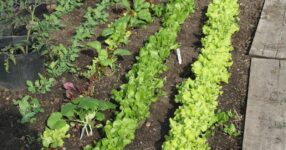
Time for fall vegetable planting
I have a few areas of my garden that are finished producing lettuce and baby greens, so I am going to plant a second crop of the same in this area. I am also going to plant cilantro again as it likes the cooler weather.
Crops that will do the best in terms of planting include lettuce, spinach, other greens, turnips, radishes, carrots and beets.
Days to maturity is one factor that determines what can be planted. Look at the seed package and check out the days to maturity. If you plant this weekend, you have about 60 days of decent growing weather for cold crops.
Crops that like warm weather (tomato, pepper, squash, etc.) will not do well in the fall. They prefer warm summer evenings, and we are entering the phase where nights are in the 50s and 60s. These plants will not develop properly unless you are growing them in a heated greenhouse.
Even with a heated greenhouse, it’s a struggle to grow tomatoes and peppers all winter. It takes lighting and warm temperatures, and most homeowners don’t have this capacity.
Prepare the soil just like you would for spring planting. The difference in fall planting is that you might have to water the seeds to get them started and keep watering the plants if it stays dry.
Covering the new crop with a row cover or greenhouse-type material increases the length of harvesting in the fall. These plants tolerate cool temperatures, but won’t tolerate freezing temperatures.
Season extension is not new, growers have been doing it for quite some time. For a homeowner, there are a few things to think about.
Any type of grow cover works but think about the material. If you use something that is more like fabric, the air moves through it easily. However, it might not be enough protection for nights that dip into freezing temperatures.
Plastic also works quite well, however, in September and October we typically have nice warm sunny days. These days are perfect for growing, but keep in mind the air under the plastic heats up and is too warm for plants. You will need to figure out a way to ventilate under the plastic.
You can also use straw or some other type of mulch in the fall for root crops such as beets, turnips, and carrots. Cover the plants with about a foot of mulch and it keeps the temperature moderate around the plant.
I have never tried the season extension because for me, it’s a lot of work. Maybe when I retire, I will have some time to play around with it. Happy planting.
Pamela Corle-Bennett is the state master gardener volunteer coordinator and horticulture educator for Ohio State University Extension. Contact her by email at bennett.27@osu.edu.



